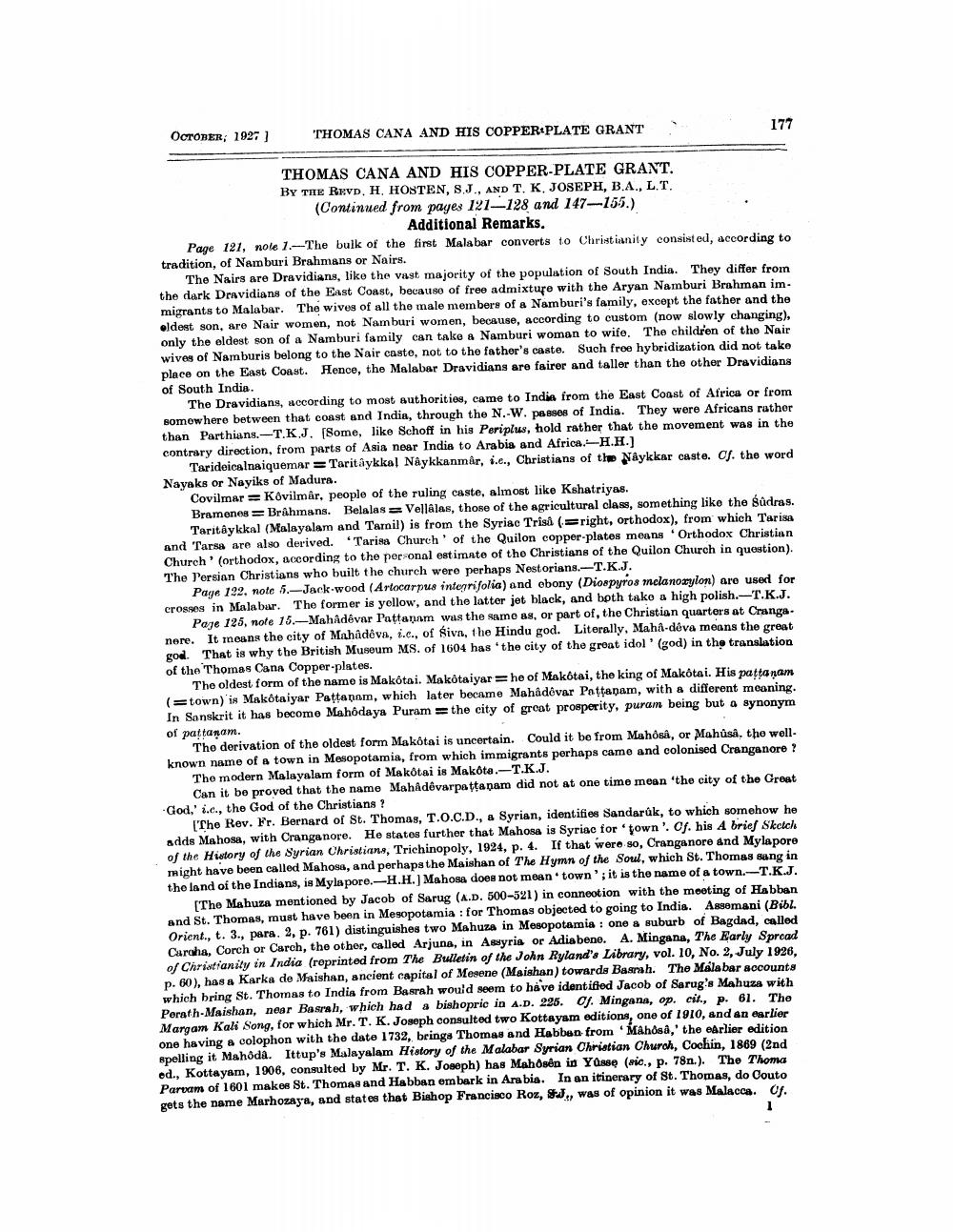________________
OCTONER; 1927
THOMAS CANA AND HIS COPPER+PLATE GRANT
177
THOMAS CANA AND HIS COPPER-PLATE GRANT. BY THE REVO, H, HOSTEN, S.J., AND T, K, JOSEPH, B.A., LT. (Continued from payes 121-128 and 147-155.)
Additional Remarks. Page 121, nole 1. The bulk of the first Malabar converts to Christianity consisted, according to tradition, of Namburi Brahmans or Nairs.
The Nairs are Dravidians, like the vast majority of the population of South India. They differ from the dark Dravidians of the East Coast, because of free admixture with the Aryan Namburi Brahman im. migrants to Malabar. The wives of all the male members of a Namburi's family, except the father and the oldest son, are Nair women, not Namburi women, because, according to custom (now slowly changing), only the eldest son of a Namburi family can take a Namburi woman to wife. The children of the Nair wives of Namburis belong to the Nair caste, not to the father's caste. Such froe hybridization did not take place on the East Coast. Hence, the Malabar Dravidians are fairer and taller than the other Dravidians of South India.
The Dravidians, according to most authorities, came to India from the East Coast of Africa or from somewhere between that coast and India, through the N.-W. Passes of India. They were Africans rather than Parthians.-T.K.J. (Some, like Schoff in his Periplus, hold rather that the movement was in the contrary direction, from parts of Asia near India to Arabia and Africa. H.H.]
Tarideicalnaiquemar = Taritâykka! Näykkanmar, i.e., Christians of the Náykkar caste. Cf. the word Nayaks or Nayiks of Madura.
Covilmar Kovilmar, people of the ruling caste, almost like Kshatriyas. Bramenes = Brahmans. Belalas = Vellalas, those of the agricultural class, something like the sūdras.
Taritaykkal (Malayalam and Tarnil) is from the Syriac Trisa (=right, Orthodox), from which Tarisa and Tarsa are also derived. *Tarisa Church of the Quilon copper-plates means Orthodox Christian Church' (orthodox, according to the per-onal estimate of the Christians of the Quilon Church in question). The l'ersian Christians who built the church were perhaps Nestorians.-T.KJ.
Page 122. note 5.-Jack-wood (Artocarpus integrifolia) and obony (Diospyros melanoxylon) are used for crosses in Malabar. The former is yellow, and the latter jet black, and both take a high polish. T.K.J.
Paje 125, note 15.-Mahadevar Pattanam was the same as, or part of, the Christian quarters at Cranga. nore. It means the city of Mahadeva, i.c., of siva, the Hindu god. Literally, Mahå-déva means the great god. That is why the British Museum MS. of 1604 has the city of the great idol' (god) in thọ translation of the Thomas Cana Copper-plates.
The oldest form of the name is Makotai. Maktaiyar =he of Maktai, the king of Makótei. His pattanam (=town) is Makotaiyar Pattanam, which later became Mahadevar Pattanam, with a different meaning. In Sanskrit it has become Mahôdaya Puram = the city of great prosperity, puram being but a synonym of pattanam.
Tho derivation of the oldest form Makotai is uncertain. Could it be from Mahsa, or Mahúsa, the wellknown name of a town in Mesopotamia, from which immigrants perhaps came and colonised Cranganore ?
The modern Malayalam form of Makotai is Makota.-T.K.J.
Can it be proved that the name MahAdóvarpattanam did not at one time mean the city of the Great God,' i.c., the God of the Christians ?
'The Rev. Fr. Bernard of St. Thomas, T.O.C.D., a Syrian, identifies Sandarák, to which somehow he adds Mahosa, with Cranganore. He states further that Mahosa is Syriac for town'. Of his A brief Sketch of the History of the Syrian Christians, Trichinopoly, 1924, p. 4. If that were so, Cranganore and Mylapore might have been called Mahosa, and perhaps the Maishan of The Hymn of the Soul, which St. Thomas sang in the land of the Indians, is Mylapore.-H.H.) Mahosa does not mean town'; it is the name of a town.-T.K.J.
The Mahuza mentioned by Jacob of Sarug (A.D. 500-521) in conneotion with the meeting of Habban and St. Thomas, must have been in Mesopotamia : for Thomas objected to going to India. Assomani (Bibl. Orient., t. 3., para. 3, p. 761) distinguishes two Mahuza in Mesopotamia : one a suburb of Bagdad, called Caroha, Corch or Caroh, the other, called Arjuna, in Assyria or Adiabene. A. Mingana, The Early Spread of Christianity in India (roprinted from The Bulletin of the John Ryland's Library, vol. 10, No. 2, July 1926. p. 60), hasa Karka de Maishan, ancient capital of Mesene (Maishan) towards Barnsh. The Malabar accounts which bring St. Thomas to India from Barrah would seem to have identified Jacob of Sarug's Mahuza with Perath-Maishan, near Basrah, which had a bishopric in A.D. 226. Of. Mingana, op. cit., p. 61. The Margam Kali Song, for which Mr. T. K. Joseph consulted two Kottayam editions, one of 1910, and an earlier one having a colophon with the date 1732, brings Thomas and Habban from Mahs8,' the earlier edition spelling it Mahoda. Ittup's Malayalam History of the Malabar Syrian Christian Church, Cochin, 1869 (2nd od., Kottayam, 1906, consulted by Mr. T. K. Joseph) has Mahsên in Yasse (ric., p. 78n.). The Thoma Parvam of 1601 makes St. Thomas and Habban embark in Arabia. In an itinerary of St. Thomas, do Couto gets the name Marhozaya, and states that Bishop Francisco Roz, J., was of opinion it was Malacca. Of.




